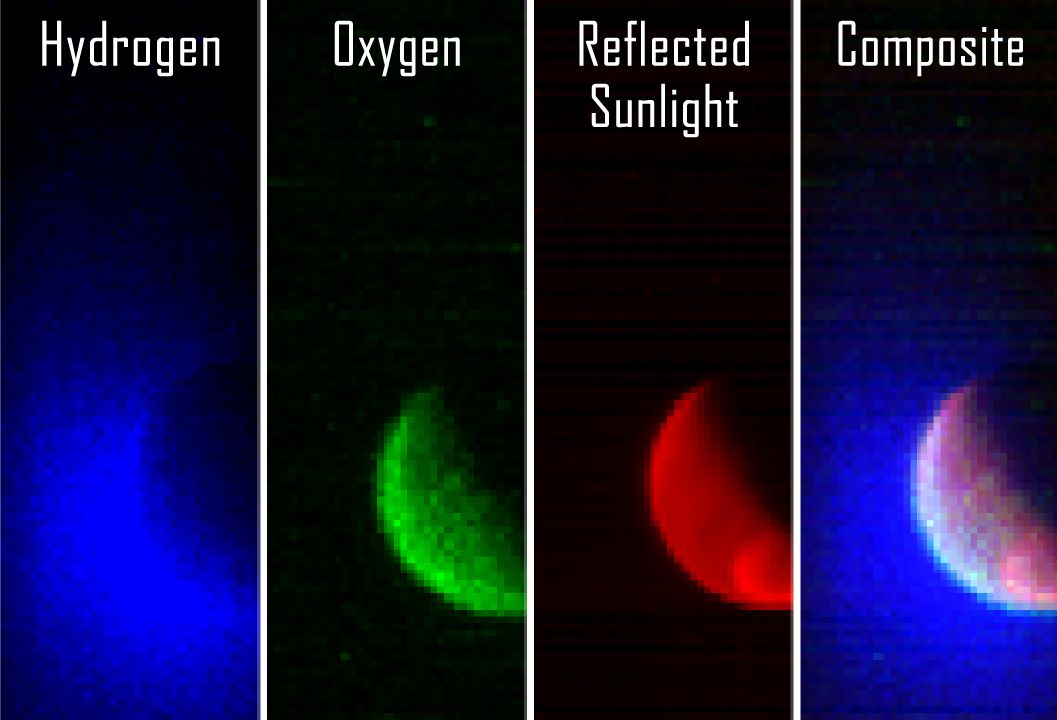
NASA's MAVEN spacecraft isn't wasting any time at Mars.
MAVEN sent home its first images of Mars' upper atmosphere early Monday morning (Sept. 22), just eight hours after entering orbit around the Red Planet.
The false-color images, which NASA released Wednesday (Sept. 24), were captured by MAVEN's Imaging Ultraviolet Spectrograph instrument when the probe was 22,680 miles (36,500 kilometers) above the surface of Mars, agency officials said.
"Blue shows the ultraviolet light from the sun scattered from atomic hydrogen gas in an extended cloud that goes to thousands of kilometers above the planet’s surface," NASA officials wrote in an online description of the image.
"Green shows a different wavelength of ultraviolet light that is primarily sunlight reflected off of atomic oxygen, showing the smaller oxygen cloud," they added. "Red shows ultraviolet sunlight reflected from the planet’s surface; the bright spot in the lower right is light reflected either from polar ice or clouds."
The $671 million MAVEN mission, whose name is short for Mars Atmosphere and Volatile Evolution, is NASA's first effort to study the Red Planet's upper atmosphere. MAVEN will use its three onboard instrument suites to measure the rate of gas escape into space, in an attempt to better understand why Mars lost most of its atmosphere over the eons. (The planet's air was relatively thick in the ancient past but is now just 1 percent as dense as that of Earth.)
MAVEN's observations should shed light on how and why Mars transitioned from a warm and wet world billions of years ago to the cold, dry planet we know today, mission scientists have said.
Get the Space.com Newsletter
Breaking space news, the latest updates on rocket launches, skywatching events and more!
The spacecraft is now in a commissioning phase, during which mission team members will lower MAVEN to its final orbit and check out its science gear. The probe's one-year science mission is scheduled to start in early November.
MAVEN isn't the only new arrival at Mars. On Tuesday night (Sept. 23), just two days after MAVEN's orbital insertion, India's first-ever Red Planet effort, the $74 million Mars Orbiter Mission, was captured by the planet's gravity as well.
Follow Mike Wall on Twitter @michaeldwall and Google+. Follow us @Spacedotcom, Facebook or Google+. Originally published on Space.com.
Join our Space Forums to keep talking space on the latest missions, night sky and more! And if you have a news tip, correction or comment, let us know at: community@space.com.

Michael Wall is a Senior Space Writer with Space.com and joined the team in 2010. He primarily covers exoplanets, spaceflight and military space, but has been known to dabble in the space art beat. His book about the search for alien life, "Out There," was published on Nov. 13, 2018. Before becoming a science writer, Michael worked as a herpetologist and wildlife biologist. He has a Ph.D. in evolutionary biology from the University of Sydney, Australia, a bachelor's degree from the University of Arizona, and a graduate certificate in science writing from the University of California, Santa Cruz. To find out what his latest project is, you can follow Michael on Twitter.









